|
Dalmatian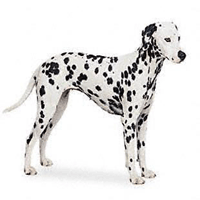
This breed was originally from Yugoslavia
but was developed in Great Britain. There used to be a custom of this dog
preceding the carriages of the English aristocracy. Slowly this custom gave
way to the dog being made to sit in the rear side of the carriage! This
breed over the years was has worked in many posts and has been outstanding
in most of the work assigned to them. This dog has served as a dog of war
and also as a sentinel. They were used as drought dogs and also as
shepherds. In London these dogs were not only mascots but also effective
rodent controllers for the fire departments. This dog has been called by
many names including "fire-house dog", "spotted dick", "plum pudding dog"
and most recently as Dally. This dog has also been used by circus clowns
for centuries. This dog also played a major role in game hunting. The latest
role this breed has adopted is that of a loving
family pet. It has taken
part in numerous movies the most famous probably being "101 Dalmatians" .
The Dalmatian is a strong active dog free
of coarseness capable of endurance and speed. The head is moderately long
skull flat yet broad between the ears. There should be no wrinkles. The
muzzle must be long and powerful. Neck must be fairly long and arched.
Forequarters must be clean and muscular. Legs must be straight and elbows
close to the body. Coat must be short, hard, dense and glossy. The colour
must have a base of pure white. There are two colours for the spots i.e.
Black or Liver spotted. The spots must be round and well defined. The height
must be between 19 – 24 inches for an adult Dalmatian. This dog needs an
regular brushing. These dogs are very active and need ample and free
exercise. This is a sound friendly dog loyal and lively. This dog has a good
life expectancy. It is a medium sized faithful and admirable companion. It
is not advised to leave this dog alone for long periods of time. On the
whole this is a wonderful dog to keep as a pet. The only point to be taken
care is that this breed needs a lot of exercise and therefore the owner must
be prepared to spare enough time and energy for this.
Great Dan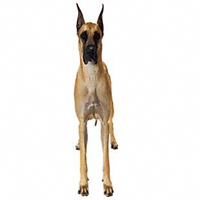 e e
This gentle giant is one of the largest
and heaviest dog breeds. Unlike as the name suggests this breed did not
evolve from Denmark. The present standards of excellence were achieved in
Germany. The Iron Chancellor of Germany Bismark had these dogs as his
personal security. The literal meaning of Great Dane is " Apollo of Dogs".
This breed is second only to the Irish Wolfhound in size. It is the fifth
heaviest dog breed in the world. The only criteria to own these giants is
adequate space. Though this dog is very friendly the original purpose they
were kept is different. They were expected to hunt and destroy Wild Boars.
For this they were bred to gain weight, nobility, courage, speed and
endurance. They have no aggressive nature in them and are friendly with
strangers. These dogs have wonderful temperaments and are good with
children. They are good pets in those houses where there is adequate space
for them. This dog is very intelligent and therefore well trained.
This dog will need a reasonable amount of exercise.
Being a large breed means that they have
to be fed a lot both in quantity and quality. Their need for nutrients is
higher than other breeds as pups. They are not the longest living among the
Canine world. These dogs have an elegant outline with alert and brisk walk.
They are not suited for obvious reasons to lives in Apartments. They need to
be given good care though grooming is not much of a problem because of their
short coats. These dogs can get bone-related problems if they are not given
good and adequate nutritional supplementation. They tend to have large
litters and the record for this breed is 19 pups. The males must weigh a
minimum of 54 kg and females 46 kg. Males must have a minimum height of 28 –
30 inches and females 68 –71 inches. These dogs must have a short dense
sleek looking coat. Accepted colours include Brindle , Fawn , Black, Blue
and Harlequin. They must be remarkable in size muscular and strongly built.
The head must be proportional to the size of the dog. The bridge of the nose
must be wide and dark fairly deeply set medium eyes are preferred. Ears must
be small and set high and can even be cropped. A long arched neck, muscular
shoulders are needed. The body should be very deep. The hindquarters and
thigh must be muscular. The feet must be cat like with arched toes. The tail
must be thick at the root and must continue to taper down. The nails must be
dark. This dog is a pleasure to associate with. They however need a lot of
space and exercise. They are so friendly that your young ones can rest
assured with these dogs. I would rate these dogs as high as 9 /10 and If any
points are to be reduced then it is because of the great amount of care
needed to maintain them. But for those of you who can afford to keep them
and devote time to them these are second to none.
Spitz
This is one of the older descendents of
dogs and are rumored to have descen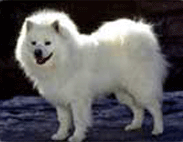 ded approximately
6000 years ago. They are dominant members of the Canine family. These dogs
are sometimes referred as "The Northern Dogs". In India we have both the
Japanese Spitz and the Pomeranian. In general people call both the dogs
"Spitz". The difference between the two is clear-cut. The Pomeranian is a
member of the Spitz family. However it is smaller in size and weigh around 2
kg. They are small compact dogs and all whole colors are accepted. They are
double coated with abundant fur in the forequarters. They are lion hearted
dogs needing little exercise. They are alert amusing and are very
affectionate. The most important aspect of this breed is that they are hardy
animals. They tend to have long lives. They however need a lot of care when
they are pups.. It can serve as an excellent watchdog. The Spitz has a wedge
shaped body, a sharp muzzle, almond eyes, erect ears, broad and deep chest,
moderately angulated hind legs, dark nails, cat like feet, tail of moderate
length curled over the back and a nimble gait. The dog does not need any
particular extra exercise. It tends to be quite happy at home but like any
other breed will enjoy a romp in the park. This dog however does need to be
groomed and daily combing is advised. These dogs may have a white coat but
tend to keep themselves quite clean. A fortnightly bath will keep them in
good shape. Their temperament may vary but most are lively, happy, and
affectionate. Some dogs may however be exceptionally moody. This dog is
devoted to the family and its sharp hearing makes it an excellent watchdog.
They tend to mix quite well with the family. This dog is recommended
particularly for those people living in flats who want a lively pet and
suffer from space constraint or the elderly needing an attentive pet which
does not need elaborate exercise. These dogs are lots of fun as pups. ded approximately
6000 years ago. They are dominant members of the Canine family. These dogs
are sometimes referred as "The Northern Dogs". In India we have both the
Japanese Spitz and the Pomeranian. In general people call both the dogs
"Spitz". The difference between the two is clear-cut. The Pomeranian is a
member of the Spitz family. However it is smaller in size and weigh around 2
kg. They are small compact dogs and all whole colors are accepted. They are
double coated with abundant fur in the forequarters. They are lion hearted
dogs needing little exercise. They are alert amusing and are very
affectionate. The most important aspect of this breed is that they are hardy
animals. They tend to have long lives. They however need a lot of care when
they are pups.. It can serve as an excellent watchdog. The Spitz has a wedge
shaped body, a sharp muzzle, almond eyes, erect ears, broad and deep chest,
moderately angulated hind legs, dark nails, cat like feet, tail of moderate
length curled over the back and a nimble gait. The dog does not need any
particular extra exercise. It tends to be quite happy at home but like any
other breed will enjoy a romp in the park. This dog however does need to be
groomed and daily combing is advised. These dogs may have a white coat but
tend to keep themselves quite clean. A fortnightly bath will keep them in
good shape. Their temperament may vary but most are lively, happy, and
affectionate. Some dogs may however be exceptionally moody. This dog is
devoted to the family and its sharp hearing makes it an excellent watchdog.
They tend to mix quite well with the family. This dog is recommended
particularly for those people living in flats who want a lively pet and
suffer from space constraint or the elderly needing an attentive pet which
does not need elaborate exercise. These dogs are lots of fun as pups.
Boxer and German Shepherd
To love and t o
be loved has been one of the basic needs in the heart of all mankind. To
find a steady friend on whom one can depend at all times in ones moments of
happiness and grief, triumphs and failures has always been mans basic
desire. An Alsatian for staunch support and dependability or a Boxer for
friendship, sport and companionship could be an answer to these desires.
Guard dogs have been in demand from time immemorial. Their loyalty has
earned them the coveted title of being ‘man’s best friend’. Most of the
present day guard dogs have originated in Europe. This is primarily because
the two World wars were fought there and numerous Breeds had been developed
to protect the boundaries from hostilities. Two of the more famous breeds of
‘war dogs’ – the Boxer and the Alsatian are today found worldwide as
domestic and industrial watchdogs. The Boxer is my ideal choice as both a
watchdog and family companion. Boxers were bred by mixing bloodlines of the
Mastiff, Pinchers and Bulldogs. This dog fits the billing of a
‘general-utility and security dog’. They originated from Germany and in just
a short span of three decades, this breed has stormed the popularity charts.
It is said that ‘beauty lies in the beholders eyes’ and truly the charm of a
Boxer lies in its ugliness! Generous wrinkles, a snub nose and drooping
lips-- what more could one look for in ugliness! And yet how beautifully
ugly these dogs are. Today Boxers are used for protection and also as
companions for children. Indeed their versatile and amenable temperament is
one of their strongest plus points. Boxers are medium sized animals, two
feet in height, weighing around 30 kg. They have a short coat, making it
very easy to groom. Accepted colours include Fawn and Brindle with varying
shades of white. (Pure White Boxers are not given entry in dog shows.) They
have an undershot mouth with wide and strong jaws. With their deep chest and
muscular back, this breed presents a rather ferocious exterior that
incidentally masks a fun loving and cheerful disposition. Their tails are
docked at birth and their ears may be cropped. Their temperament can be
described as docile yet alert. They need a lot of love and do well with a
long run in the park. Their main problem lies in the fact that they drool a
lot in summers and can give quite a slobbery kiss! Their face is an
excellent deterrent to any robber. They can be distrustful of strangers. In
case the prospective owner has young children, enough space, and needs
protection, this breed is recommended. Though endowed with reasonably good
health, as with other large breeds they are not known for a very long life
span. Owners may consider a
dog health insurance plan for
unforseen health issues. But this breed on the whole is a pleasure to own. o
be loved has been one of the basic needs in the heart of all mankind. To
find a steady friend on whom one can depend at all times in ones moments of
happiness and grief, triumphs and failures has always been mans basic
desire. An Alsatian for staunch support and dependability or a Boxer for
friendship, sport and companionship could be an answer to these desires.
Guard dogs have been in demand from time immemorial. Their loyalty has
earned them the coveted title of being ‘man’s best friend’. Most of the
present day guard dogs have originated in Europe. This is primarily because
the two World wars were fought there and numerous Breeds had been developed
to protect the boundaries from hostilities. Two of the more famous breeds of
‘war dogs’ – the Boxer and the Alsatian are today found worldwide as
domestic and industrial watchdogs. The Boxer is my ideal choice as both a
watchdog and family companion. Boxers were bred by mixing bloodlines of the
Mastiff, Pinchers and Bulldogs. This dog fits the billing of a
‘general-utility and security dog’. They originated from Germany and in just
a short span of three decades, this breed has stormed the popularity charts.
It is said that ‘beauty lies in the beholders eyes’ and truly the charm of a
Boxer lies in its ugliness! Generous wrinkles, a snub nose and drooping
lips-- what more could one look for in ugliness! And yet how beautifully
ugly these dogs are. Today Boxers are used for protection and also as
companions for children. Indeed their versatile and amenable temperament is
one of their strongest plus points. Boxers are medium sized animals, two
feet in height, weighing around 30 kg. They have a short coat, making it
very easy to groom. Accepted colours include Fawn and Brindle with varying
shades of white. (Pure White Boxers are not given entry in dog shows.) They
have an undershot mouth with wide and strong jaws. With their deep chest and
muscular back, this breed presents a rather ferocious exterior that
incidentally masks a fun loving and cheerful disposition. Their tails are
docked at birth and their ears may be cropped. Their temperament can be
described as docile yet alert. They need a lot of love and do well with a
long run in the park. Their main problem lies in the fact that they drool a
lot in summers and can give quite a slobbery kiss! Their face is an
excellent deterrent to any robber. They can be distrustful of strangers. In
case the prospective owner has young children, enough space, and needs
protection, this breed is recommended. Though endowed with reasonably good
health, as with other large breeds they are not known for a very long life
span. Owners may consider a
dog health insurance plan for
unforseen health issues. But this breed on the whole is a pleasure to own.
The German Shepherd or the Alsatian
probably is the world’s most popular guard dog. They are used by Military
and Police squads for protection and detection of narcotics. They are also
the first choice as guide dogs for blind school members. Alsatians are
around two feet in height weighing around 35 kg. They are generally black
and tan in colour. Their face is generally long and clear cut with moderate
sized erect ears. They can have either a single coat or a wooly double coat.
The latter are not suited to hot tropical conditions, as in Delhi. Ideally,
the body configuration of this breed must have a long neck and sloping
shoulders. The body must be well boned and evenly muscled. The tail should
hang downwards in a slight curve. Alsatians need a lot of special care and
plenty of exercise. They should not be left tied up for long periods. By
nature they tend to be aloof and prefer the company of one particular member
of the family, generally the most dominant person (hence the term ‘one-man’
dogs). Alsatians are extremely intelligent, confident, vigilant and
fearless. Given proper training this breed proves to be a totally dependable
companion. However these dogs need to do some work and leaving them idle
could spoil their disposition. Over a period of time these dogs have been
bred rather injudiciously. This has led to the emergence of a rather
delicate breed. The main problem this breed faces today is of Hip-dysplasia.
Almost 25% of the members of this breed tend to suffer from this malady
wherein there is a drastic alteration of the muscle-bone ratio. This leads
to eventu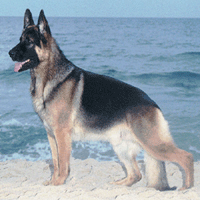 al
paralysis in afflicted animals. They are also prone to ear and anal gland
problems. These facts however do not alter the fact that these animals
remain at the top of the canine popularity chart. They have a worldwide,
ever expanding fan club. Both the Boxer and the Alsatian are good
guard-dogs. While the latter need firm handling, boxers are more friendly
and easier to handle. Again while Alsatians have to be meticulously groomed
to prevent shedding of hair in summers, boxers hardly shed any. . Both are
active breeds and are not happy with sedate walks. I have personally enjoyed
the pleasure of owning both these breeds and feel that each has a unique
charm. They are both very loyal and one can be assured of a restful sleep
with them around to guard the premises. al
paralysis in afflicted animals. They are also prone to ear and anal gland
problems. These facts however do not alter the fact that these animals
remain at the top of the canine popularity chart. They have a worldwide,
ever expanding fan club. Both the Boxer and the Alsatian are good
guard-dogs. While the latter need firm handling, boxers are more friendly
and easier to handle. Again while Alsatians have to be meticulously groomed
to prevent shedding of hair in summers, boxers hardly shed any. . Both are
active breeds and are not happy with sedate walks. I have personally enjoyed
the pleasure of owning both these breeds and feel that each has a unique
charm. They are both very loyal and one can be assured of a restful sleep
with them around to guard the premises.
Doberman & Rottweiler
With the crime situation being what it is in like today, the need for reliable guard dogs
is increasingly being felt. A well-trained guard dog is a much safer bet any
day than a watchman is. There are numerous breeds, which serve as excellent
guard dogs, but the most outstanding include the Alsatian, Boxer, Doberman
and the Rottweiler. I had written earlier about the former two and in this
article we shall discuss the Doberman and the Rottweiler. These two breeds
require very strict, proper handling and training. My advice to those who
intend to own these two breeds – especially to those who are going in for a
pet for the first time to think twice before embarking on this project. In
the past there have been a few instances of Rottweilers running amok. The
most recent episode was when a dog of this breed had attacked some children
in South Delhi. To put the blame entirely on these dogs for these incidents
is unfair. I have come across a lot of people keeping these large dogs in
flats or other restricted quarters. A few people also go in for these dogs
without prior thought and after a certain period of time as the dogs grow up
they find it difficult to handle them. To control these pets and to remedy
matters they then tie them up and this aggravates the problem. Any large dog
that is untrained and has a violent disposition is a serious menace to both
the owner and the neighbors. Owners would better go in for a professional
trainer to overcome this problem. In case a person plans to go in for this
breed then he should have enough time and space with him. This breed is an
excellent choice for farmhouses and large bungalows. Rottweilers have a
relatively ancient history. They were used by the Roman army to herd cattle
that were meant to be the food supply for the soldiers! They were later used
as ‘anti-bandit’ dogs. This background has ensured that till date this breed
is considered as an excellent police dog. These dogs have many plus points--
they are very strong and robust and are extremely intelligent. They are
highly trainable but need to be handled firmly when young. They are bold and
courageous. They require a lot of exercise. Care should be taken that they
must not be over-exercised during the growing stages. Exercise needs to be
gradually increased. They have to be fed well and need special care during
the initial years. The male Rottweiler should ideally be 25 – 27 inches
tall, females being two inches less. They are black with clear-cut tan
markings. These compact animals are well proportioned with a straight firm
back and strong muscles. The feet are strong and short and give the breed
the special gait. The gait of a Rottweiler would show strength, endurance
and purpose. The tail is cut at the first joint. They can weigh between 35 –
45 kg. The Doberman was literally ‘manufactured’ by a German breeder Louis
Doberman after extensive experimental breeding keeping certain qualities in
mind. The product we have got today is an agile, strong and sensible guard
dog. The basic stock of the Doberman was the Rottweiler and hence one can
expect quite a few similarities. However unlike the more aggressive
Rottweiler this dog is also an excellent family dog and is a good playmate
for the children. These animals also need a lot of exercise. They are
energetic, bold and intelligent. As with other guard dogs they need firm
handling when young. The most impressive feature is that at 27 inches, this
dog has a powerful body and fearless appearance. They have a wedge shaped
body and the eyes impart an energetic appearance. The body is muscular with
a short back and square chest. The tail is docked at the second vertebrae
and held high. Accepted colors include black, fawn, red and blue. The ears
may be cropped. This breed can weigh between 30 – 35 kg. The front legs must
be straight and the hind legs angulated. The last few years have witnessed
some reckless breeding among this breed leading to the dilution of the
genetic stock and subsequent loss in popularity. When selecting pups of both
these breeds discussed above, care must be t
situation being what it is in like today, the need for reliable guard dogs
is increasingly being felt. A well-trained guard dog is a much safer bet any
day than a watchman is. There are numerous breeds, which serve as excellent
guard dogs, but the most outstanding include the Alsatian, Boxer, Doberman
and the Rottweiler. I had written earlier about the former two and in this
article we shall discuss the Doberman and the Rottweiler. These two breeds
require very strict, proper handling and training. My advice to those who
intend to own these two breeds – especially to those who are going in for a
pet for the first time to think twice before embarking on this project. In
the past there have been a few instances of Rottweilers running amok. The
most recent episode was when a dog of this breed had attacked some children
in South Delhi. To put the blame entirely on these dogs for these incidents
is unfair. I have come across a lot of people keeping these large dogs in
flats or other restricted quarters. A few people also go in for these dogs
without prior thought and after a certain period of time as the dogs grow up
they find it difficult to handle them. To control these pets and to remedy
matters they then tie them up and this aggravates the problem. Any large dog
that is untrained and has a violent disposition is a serious menace to both
the owner and the neighbors. Owners would better go in for a professional
trainer to overcome this problem. In case a person plans to go in for this
breed then he should have enough time and space with him. This breed is an
excellent choice for farmhouses and large bungalows. Rottweilers have a
relatively ancient history. They were used by the Roman army to herd cattle
that were meant to be the food supply for the soldiers! They were later used
as ‘anti-bandit’ dogs. This background has ensured that till date this breed
is considered as an excellent police dog. These dogs have many plus points--
they are very strong and robust and are extremely intelligent. They are
highly trainable but need to be handled firmly when young. They are bold and
courageous. They require a lot of exercise. Care should be taken that they
must not be over-exercised during the growing stages. Exercise needs to be
gradually increased. They have to be fed well and need special care during
the initial years. The male Rottweiler should ideally be 25 – 27 inches
tall, females being two inches less. They are black with clear-cut tan
markings. These compact animals are well proportioned with a straight firm
back and strong muscles. The feet are strong and short and give the breed
the special gait. The gait of a Rottweiler would show strength, endurance
and purpose. The tail is cut at the first joint. They can weigh between 35 –
45 kg. The Doberman was literally ‘manufactured’ by a German breeder Louis
Doberman after extensive experimental breeding keeping certain qualities in
mind. The product we have got today is an agile, strong and sensible guard
dog. The basic stock of the Doberman was the Rottweiler and hence one can
expect quite a few similarities. However unlike the more aggressive
Rottweiler this dog is also an excellent family dog and is a good playmate
for the children. These animals also need a lot of exercise. They are
energetic, bold and intelligent. As with other guard dogs they need firm
handling when young. The most impressive feature is that at 27 inches, this
dog has a powerful body and fearless appearance. They have a wedge shaped
body and the eyes impart an energetic appearance. The body is muscular with
a short back and square chest. The tail is docked at the second vertebrae
and held high. Accepted colors include black, fawn, red and blue. The ears
may be cropped. This breed can weigh between 30 – 35 kg. The front legs must
be straight and the hind legs angulated. The last few years have witnessed
some reckless breeding among this breed leading to the dilution of the
genetic stock and subsequent loss in popularity. When selecting pups of both
these breeds discussed above, care must be t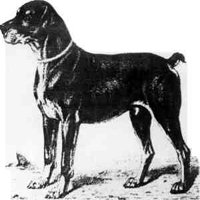 aken
to see that they are neither shy nor vicious. Both these breeds have short
coats and are therefore easy to groom. Both need a lot of exercise and are
not advised for couch potatoes. Both are very loyal and would turn out to be
stable guard dogs provided they are brought up properly. Both breeds are
suspicious of strangers and care is to be taken while introducing guests.
Visitors to households with these breeds are advised to strictly adhere to
the proverb ‘let sleeping dogs lie’! These dogs are large and can have a
good appetite so be prepared to have a heavy food bill! Inactivity tends to
make these dogs obese and this may create a problem in middle and old age
dogs. These dogs are a pleasure to own, but they make more demands on the
owner than the average pet. aken
to see that they are neither shy nor vicious. Both these breeds have short
coats and are therefore easy to groom. Both need a lot of exercise and are
not advised for couch potatoes. Both are very loyal and would turn out to be
stable guard dogs provided they are brought up properly. Both breeds are
suspicious of strangers and care is to be taken while introducing guests.
Visitors to households with these breeds are advised to strictly adhere to
the proverb ‘let sleeping dogs lie’! These dogs are large and can have a
good appetite so be prepared to have a heavy food bill! Inactivity tends to
make these dogs obese and this may create a problem in middle and old age
dogs. These dogs are a pleasure to own, but they make more demands on the
owner than the average pet.
Labrador
This blue-blooded b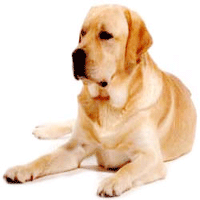 reed
was originally seen in Newfoundland where local fishermen used them to
retrieve fishing nets. They came to England in the 1830’s. Ironically
this breed lost out in popularity in Newfoundland because the authorities
levied a dog tax and the owners were unable to afford to keep Labradors! In
course of time this breed won the admiration of the British, and today they
are next in popularity only to the Alsatian all over the world. This breed
being versatile is seen to assist the bomb squads, narcotics department and
also members of the blind schools. Incidentally Labrador Retrievers are
members of the Gun-dog group but were not used initially to retrieve birds!
And amongst almost all other patients it is the Labrador that are the vets
favourite and safest handling. They are very reliable and they don’t tend to
nip the vet when he treats. An adult Labrador weighs around 30 – 35 kg and
the ideal height of a male Labrador is around 22 – 23 inches. Females are an
inch shorter. Labradors have a short dense satin smooth coat that is
waterproof in nature. They are seen in three
colours Black, Liver (Chocolate)
and Yellow. They have a broad skull (with an extremely intelligent brain!)
and their face is free of excess flesh. Ears are of moderate size hanging
close to the head. They have a deep chest and strong legs. Labs have a thick
broad tail tapering to the base. The tail must not be carried over the back
and moves about gaily. This breed needs a bit of exercise and is not suited
for the lazy owner. However the elderly can keep them, as they are happy
with a slow sedate walk. They have an excellent sense of smell. As puppies
they are very active and need someone or something to keep them occupied.
They do well with regular brushing and do not need elaborate grooming. Labs
are very good family pets and are especially good with kids because they are
endowed with an excellent disposition and a cheerful nature. Labs as a breed
have very few demands. They are however not the best of guards. . These dogs
are courageous yet peace loving. They are friendly with everybody and
universal love seems to be their motto! So, in case you are looking for a
guard dog, these benign creatures are not the best choice. They are
voracious eaters tending to be greedy at times. This contributes to their
growing obese with age. These dogs are very easily trained. One must not be
harsh with them during training, as they are very sensitive as pups. Over
the years I have come across a handful of Labs that were vicious. This is
not their natural temperament and such dogs should not be bred. People who
want only a companion and are going to be first time pet owners are
recommended to go in for this breed. Labradors are a non-problematic breed
in general. Any person who decides on this breed can rest assured that this
dog will help reduce the prevalent tension seen nowadays by their warmth,
self-assured behaviour and serene nature. Time has witnessed the evolution of
an extremely fun loving and intelligent breed that has a worldwide fan club. reed
was originally seen in Newfoundland where local fishermen used them to
retrieve fishing nets. They came to England in the 1830’s. Ironically
this breed lost out in popularity in Newfoundland because the authorities
levied a dog tax and the owners were unable to afford to keep Labradors! In
course of time this breed won the admiration of the British, and today they
are next in popularity only to the Alsatian all over the world. This breed
being versatile is seen to assist the bomb squads, narcotics department and
also members of the blind schools. Incidentally Labrador Retrievers are
members of the Gun-dog group but were not used initially to retrieve birds!
And amongst almost all other patients it is the Labrador that are the vets
favourite and safest handling. They are very reliable and they don’t tend to
nip the vet when he treats. An adult Labrador weighs around 30 – 35 kg and
the ideal height of a male Labrador is around 22 – 23 inches. Females are an
inch shorter. Labradors have a short dense satin smooth coat that is
waterproof in nature. They are seen in three
colours Black, Liver (Chocolate)
and Yellow. They have a broad skull (with an extremely intelligent brain!)
and their face is free of excess flesh. Ears are of moderate size hanging
close to the head. They have a deep chest and strong legs. Labs have a thick
broad tail tapering to the base. The tail must not be carried over the back
and moves about gaily. This breed needs a bit of exercise and is not suited
for the lazy owner. However the elderly can keep them, as they are happy
with a slow sedate walk. They have an excellent sense of smell. As puppies
they are very active and need someone or something to keep them occupied.
They do well with regular brushing and do not need elaborate grooming. Labs
are very good family pets and are especially good with kids because they are
endowed with an excellent disposition and a cheerful nature. Labs as a breed
have very few demands. They are however not the best of guards. . These dogs
are courageous yet peace loving. They are friendly with everybody and
universal love seems to be their motto! So, in case you are looking for a
guard dog, these benign creatures are not the best choice. They are
voracious eaters tending to be greedy at times. This contributes to their
growing obese with age. These dogs are very easily trained. One must not be
harsh with them during training, as they are very sensitive as pups. Over
the years I have come across a handful of Labs that were vicious. This is
not their natural temperament and such dogs should not be bred. People who
want only a companion and are going to be first time pet owners are
recommended to go in for this breed. Labradors are a non-problematic breed
in general. Any person who decides on this breed can rest assured that this
dog will help reduce the prevalent tension seen nowadays by their warmth,
self-assured behaviour and serene nature. Time has witnessed the evolution of
an extremely fun loving and intelligent breed that has a worldwide fan club.
|
